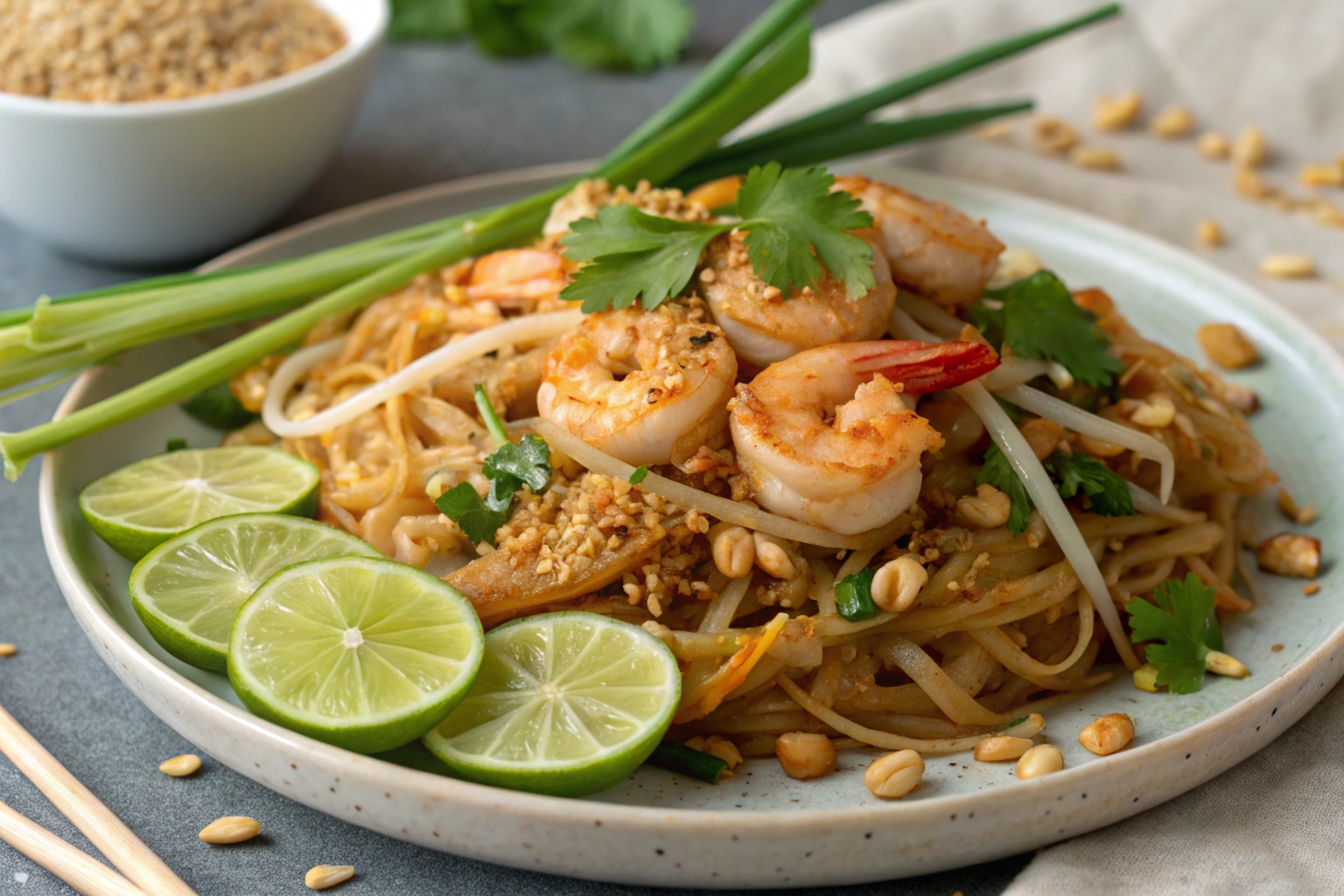want to listen to the recipe ?
Imagine the tantalizing aromas of sizzling shrimp and the vibrant colors of fresh vegetables. These are the hallmarks of Pad Thai, a beloved noodle dish that captures the essence of Thai cuisine. This blog post will guide you through making delicious Shrimp Pad Thai at home. You will discover the secrets to achieving the perfect balance of flavors and learn expert tips to create a dish that rivals your favorite Thai restaurant. Get ready for a culinary adventure that transports you to the bustling streets of Thailand, all from the comfort of your kitchen!
Understanding Pad Thai
Pad Thai is a stir-fried noodle dish that originated in Thailand. It is now a popular dish worldwide. Pad Thai consists of rice noodles, protein, a flavorful sauce, vegetables, and garnishes. The dish’s unique appeal lies in the harmonious blend of sweet, sour, salty, and spicy flavors.
Each element plays a crucial role in creating this balance. Fish sauce adds a savory depth, brown sugar brings sweetness, lime juice provides a tangy kick, and chili sauce adds heat. The combination of these distinct flavors, along with the textures of tender noodles, crunchy vegetables, and succulent shrimp, creates an unforgettable culinary experience.
Shrimp Pad Thai: Ingredients for Success
Before you embark on your Pad Thai-making journey, let’s gather the necessary ingredients.
For the Noodles:
- Rice Noodles: Opt for vermicelli or angel hair rice noodles. These delicate noodles pair perfectly with shrimp. If you prefer a heartier texture, you can use linguine-style rice noodles.
- Shrimp: Small shrimp (size 71-90) are ideal for this recipe as they are easy to eat with the other ingredients. You can use either raw or pre-cooked shrimp.
For the Sauce:
- Fish Sauce: This savory condiment adds a unique umami flavor. If you don’t have fish sauce, you can substitute it with extra soy sauce.
- Soy Sauce: Use low-sodium soy sauce for a healthier option.
- Brown Sugar: Brown sugar adds a touch of sweetness to balance the salty and sour notes.
- Lime Juice: Fresh lime juice provides a refreshing acidity that brightens the dish.
- Rice Vinegar: Rice vinegar contributes a mild, slightly sweet acidity that enhances the complexity of the sauce.
- Chili Sauce: Use chili garlic sauce, Sriracha, or red pepper flakes to add heat. Adjust the amount according to your spice preference.
For the Vegetables:
- Red Bell Pepper: Adds sweetness and crunch.
- Carrots: Use matchstick carrots for a vibrant color and a satisfying crunch.
- Snow Peas: Snow peas offer a delightful snap and a fresh, green flavor.
- Bean Sprouts: Bean sprouts add a unique texture and a slightly nutty flavor. If fresh bean sprouts are unavailable, you can use canned bean sprouts or substitute another vegetable like red bell pepper.
- Green Onions: Thinly sliced green onions provide a sharp, oniony flavor that complements the other ingredients.
For the Garnishes:
- Chopped Peanuts: Roasted peanuts add a crunchy texture and nutty flavor.
- Cilantro: Fresh cilantro adds a bright, herbaceous note that enhances the overall freshness of the dish.
- Lime Wedges: Lime wedges provide an extra burst of acidity, allowing you to adjust the tanginess of the dish to your liking.
Expert Tip: To elevate your Shrimp Pad Thai, try sourcing authentic Thai ingredients. You can find them at Asian grocery stores, online retailers, or specialty food shops. [This information is not explicitly mentioned in the sources and you may wish to independently verify it.]
[woo_product_slider id=”3030″]
A Step-by-Step Guide to Creating Shrimp Pad Thai

Now that we have our ingredients ready, let’s dive into the step-by-step process of making Shrimp Pad Thai.
- Prepare the Noodles: Soak the rice noodles in hot water according to the package instructions. Once pliable, drain them and rinse with cold water. This will prevent them from sticking together.
- Prepare the Shrimp: If using frozen shrimp, thaw them completely. You can do this by placing them in the refrigerator overnight or rinsing them under cold water for a few minutes. If you are using raw shrimp, pat them dry with paper towels.
- Make the Sauce: In a small bowl, whisk together the fish sauce, soy sauce, brown sugar, lime juice, rice vinegar, and chili sauce. Adjust the amount of chili sauce to your preferred spice level.
- Stir-Fry the Vegetables: Heat olive oil or avocado oil in a large skillet or wok over medium heat. Add the red bell pepper strips and cook, stirring occasionally, until tender. Then add the carrots, snow peas, and garlic, and cook until the carrots are softened.
- Cook the Shrimp: If you are using raw shrimp, add them to the pan with the vegetables. Cook until the shrimp turn pink and opaque, about 2 minutes per side. If you are using pre-cooked shrimp, add them later with the noodles.
- Scramble the Eggs: Push the vegetables and shrimp to one side of the pan. Pour the beaten eggs into the empty space and cook, stirring occasionally, until they are lightly scrambled.
- Add the Noodles and Sauce: Add the drained noodles and the prepared sauce to the pan. Toss everything together, ensuring the noodles are evenly coated. Cook for a few minutes, until the noodles are heated through and the sauce thickens slightly.
Expert Tip: Be careful not to overcook the shrimp. They should be tender and juicy. Overcooked shrimp will become rubbery.
- Garnish and Serve: Transfer the Pad Thai to a serving platter or individual plates. Top with chopped peanuts, fresh cilantro, and lime wedges. Serve immediately and enjoy your delicious homemade Shrimp Pad Thai!
Expert Tip: For the best Pad Thai experience, serve the dish immediately after cooking. This will ensure that the noodles retain their perfect texture and the flavors are at their peak.

Shrimp Pad Thai
Description
Shrimp Pad Thai is a classic Thai street food dish featuring tender shrimp, stir-fried rice noodles, a tangy-sweet sauce, crunchy peanuts, and fresh herbs. It’s a perfect balance of flavors and textures, making it a favorite for takeout or homemade meals.
Ingredients
For the Sauce:
For the Pad Thai:
For Garnish:
Instructions
- Prepare the Noodles 🍜
Cook the rice noodles according to the package instructions. Drain and set aside. - Mix the Sauce 🥣
In a small bowl, whisk together tamarind paste, fish sauce, soy sauce, brown sugar, rice vinegar, and chili flakes. Set aside. - Cook the Shrimp 🦐
Heat 1 tbsp vegetable oil in a large skillet or wok over medium-high heat. Add the shrimp and cook for 2-3 minutes, until pink and opaque. Remove and set aside. - Scramble the Eggs 🍳
In the same skillet, add the remaining oil and pour in the beaten eggs. Scramble gently until cooked but still soft. Push the eggs to one side of the pan. - Sauté Garlic and Vegetables 🧄🥕
Add the minced garlic to the skillet and cook for 30 seconds until fragrant. Stir in the cooked noodles, bean sprouts, shredded carrots (if using), and green onions. - Add Sauce and Shrimp 🌟
Pour the sauce over the noodles and toss to coat. Return the shrimp to the skillet and cook for 1-2 minutes, allowing the flavors to meld. - Serve and Garnish 🍽️
Plate the Pad Thai and sprinkle with chopped peanuts, fresh cilantro, and lime wedges.
Notes
- -Adjust the spice level with more chili flakes or a drizzle of sriracha.
-For a vegetarian version, replace shrimp with tofu and use soy sauce instead of fish sauce.
-Add more crunch with extra bean sprouts or chopped water chestnuts.
Beyond the Classic: Exploring Pad Thai Adaptations
While the traditional Shrimp Pad Thai is a culinary masterpiece, you can explore different adaptations to cater to various dietary preferences and tastes.
Vegetarian Pad Thai: Substitute the shrimp with tofu, tempeh, or mushrooms for a delicious vegetarian alternative. These ingredients provide a great source of protein and blend seamlessly with the other Pad Thai flavors. [16, 36. You may want to independently verify information about tempeh and mushrooms.]
Gluten-Free Pad Thai: To make a gluten-free version, ensure you use gluten-free soy sauce and fish sauce. Many brands offer gluten-free alternatives to these essential condiments.
Expert Tip: Remember to check the labels of all your ingredients to ensure they meet your dietary requirements.
Conclusion
Creating authentic Shrimp Pad Thai at home is easier than you might think. With fresh ingredients, a balanced sauce, and a little bit of culinary enthusiasm, you can transport yourself to the vibrant streets of Thailand with every bite. Experiment with the recipe, add your personal touch, and enjoy the delicious results!


